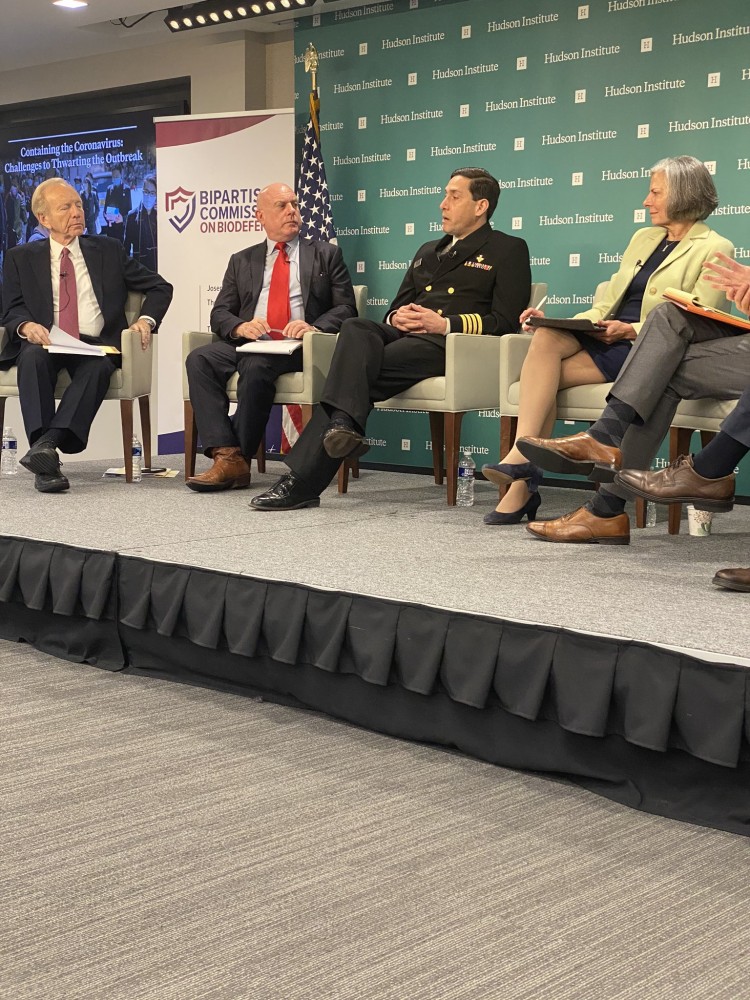
In the wake of the global coronavirus (COVID-19) outbreak, policymakers and the public are asking what more could have been done to prevent the spread of that disease.
Public health officials participated on Monday at the Hudson Institute in a panel discussion to answer that question. The talk, ‘Containing the Coronavirus: Challenges to Thwarting the Outbreak’ and co-organized by the Bipartisan Commission on Biodefense, focused on topics such as how to stop the operation of wildlife markets worldwide, to the role China’s authoritarian government might have played in the coronavirus spread.
“The most infectious diseases we’re dealing with are zoonotic in the sense that they’re transmitted to humans by various animal species,” said former U.S. Sen. Joseph Liberman, who is co-chair of the Commission. “How we deal with that is a very important question.”
William Karesh, executive vice president, EcoHealth Alliance, told the audience that there are thousands of wildlife markets in Asia alone, selling everything from bats to exotic birds and that the public shouldn’t be surprised when a coronavirus or other infectious disease outbreak occurs.
Karesh and his colleagues found 50 new coronaviruses closely related to this current one circulating in people in China. About 1 percent of the population has antibodies to these coronaviruses, demonstrating that people have been contracting these viruses for quite some time.
“Everybody says there is nothing we can do about (wildlife markets) but I disagree with that,” Karesh said, adding that demographic changes and technology, such as refrigeration and cold storage, are making these markets less appealing to the younger population.
“The demographic in the middle … they are not interested in eating bats and this kind of food. They’d much rather go to Pizza Hut,” he said. “I think there’s an opportunity with this social behavior change, especially with social media that is rapidly growing in these parts of the world, that we can shift away from that.”
The discussion later evolved to social media and the Chinese people’s use of that technology. Commentary on these platforms show that many “… people don’t trust what the Chinese Communist Party is telling them (about the coronavirus),” said Eric Brown, senior fellow, Hudson Institute.
This, he said, has contributed to a lot of conspiracy theories. The Communist Party clamps down on the population with draconian measures while at the same time spinning propaganda, which then leads to paranoia. The Party has total control of information that goes in and out of the country and “with an issue like (the coronavirus), it has implications for every country in the world,” Brown said.
Despite these concerns, Julie Gerberding, executive vice president at Merck, pointed out that what the world has witnessed in China is the “most sophisticated and complete containment effort that has ever been invoked … then you surround that with the travel restrictions that are being implemented. It’s definitely the best possible effort to contain something at the source.”
However, if sustained local transmission happens, containment is no longer the goal. Instead, the policy is to slow down the spread of the coronavirus and reduce the peak. If the peak is not minimized, it infringes on health professionals’ ability to care for patients and provide essential medical services, Gerberding said.
The next move is to slow down the spread of the virus, and this is where social distancing becomes important: the population avoids congregating en mass and places such as schools.
“Right now, we’re at the spill-over phase and we don’t know what’s going to happen next,” Gerberding said.
Daniel Chertow, head of the Emerging Pathogens Section at National Institutes of Health, reiterated the point that microbes don’t respect international boundaries and that it’s essential to share clinical data, despite China’s authoritarian government. This also reduces reduplication of efforts so that time and money can be spent on other aspects of viral containment.
Researchers still seek answers to medical questions surrounding the coronavirus.
“Is the reported fatality rate at 2 percent the true case fatality rate?” Chertow asked. “And is there asymptomatic shedding?”, which is the presence of a virus despite no clinical signs or symptoms.
The NIH, part of the National Biodefense Strategy, is on the frontlines of this global health security crisis. Established in 2018, the mission of the Strategy is a more centralized approach to biodefense.
“Biodefense touches every part of every executive of every department and agency and is also throughout every element and every facet of the intelligence community,” said Tim Morrison, senior fellow at the Hudson Institute. “In terms of trying to wrap our arms around that to determine who is accountable and who is in charge, the Biodefense Strategy was born.”
The Biomedical Advanced Research and Development Authority (BARDA), an agency of the HHS Office of the Assistant Secretary for Preparedness and Response, is part of the Strategy and is moving forward on a diagnostic technology that could aid in the coronavirus response. And earlier this month the Centers for Disease Control and Prevention began shipping novel coronavirus test kits to labs in the United States and abroad.
However, Morrison questioned how responsive scientists can be in a crisis when “we’re still making our vaccines tied to eggs.”
Scientists are developing platforms to better mass-produce vaccines, though egg-based vaccine manufacturing is still common for diseases such as influenza.




